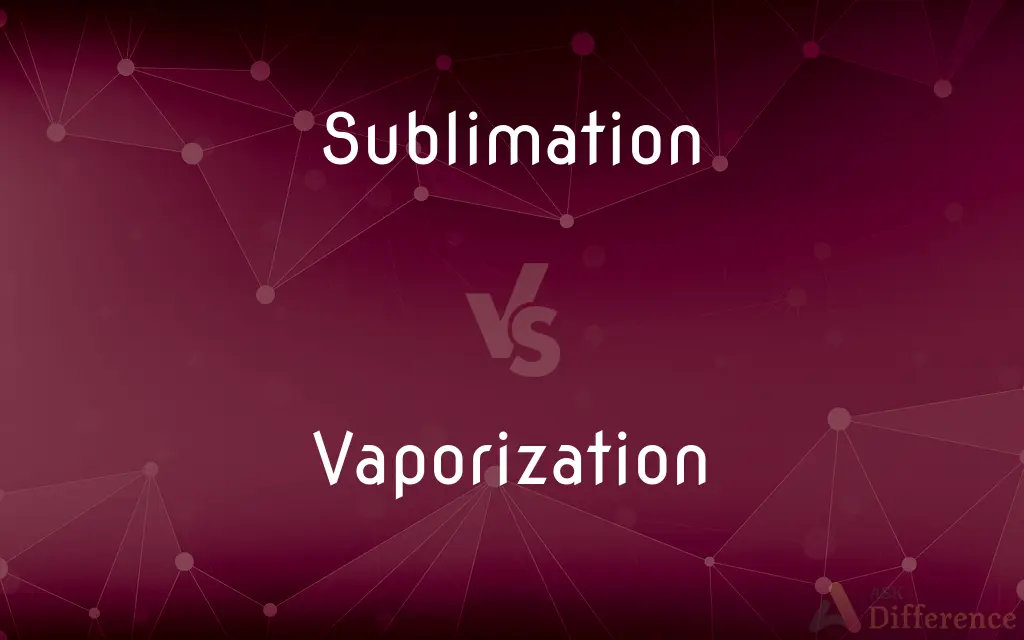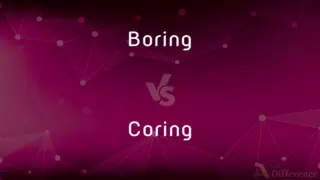Sublimation vs. Vaporization — What's the Difference?
By Fiza Rafique & Urooj Arif — Updated on April 17, 2024
Sublimation is the direct conversion of a solid to gas without becoming liquid, while vaporization involves a liquid turning into gas, typically through boiling or evaporation.

Difference Between Sublimation and Vaporization
Table of Contents
ADVERTISEMENT
Key Differences
Sublimation occurs under specific conditions where a solid transitions directly to a gas phase, skipping the liquid state, commonly seen in dry ice. Whereas vaporization is the process where liquids are converted into gas, either by boiling under heat or evaporating when exposed to air.
In sublimation, the substances that undergo this change usually have unique molecular structures that allow them to vaporize at lower pressures, such as frozen carbon dioxide. On the other hand, vaporization typically involves common liquids like water, which requires heat to transition into steam.
Sublimation can occur at various temperatures and pressures, often observed in vacuum conditions or at atmospheric pressure under very low temperatures. Conversely, vaporization primarily depends on temperature and the liquid's boiling point, with higher temperatures speeding up the process.
Substances that sublimate, such as iodine or naphthalene, often leave no residue as they transition from solid to gas. In contrast, during vaporization, some residue may remain if the liquid contains non-volatile solutes or impurities, such as in saltwater.
The equipment required for sublimation includes a setup that can maintain low pressure or specific temperature conditions, like freeze-drying systems. Meanwhile, vaporization equipment ranges from simple open pans for evaporation to controlled pressure boilers for industrial applications.
ADVERTISEMENT
Comparison Chart
Phase change
Solid to gas
Liquid to gas
Conditions
Low pressure or specific temperatures
High temperatures or open exposure
Common substances
Dry ice, iodine
Water, alcohol
Residue
No residue typically
Possible residue from solutes
Equipment
Freeze-dryers, vacuum chambers
Boilers, pans, evaporators
Compare with Definitions
Sublimation
A psychological defense mechanism.
Freud described sublimation as redirecting instinctual drives into acceptable activities.
Vaporization
Used in various industrial processes.
Vaporization is crucial in the distillation of crude oil.
Sublimation
A process used in printing technology.
In dye-sublimation printing, solid dyes turn into gas and bond with the print material.
Vaporization
Can occur naturally.
Puddles gradually disappear after a rain due to vaporization.
Sublimation
A method for purifying compounds.
Sublimation is often used to purify naphthalene in laboratories.
Vaporization
A phase transition from liquid to gas.
Boiling water on a stove demonstrates vaporization as it turns to steam.
Sublimation
Occurs under specific environmental conditions.
Frost can sublimate during dry, cold weather, directly turning into vapor without melting.
Vaporization
Depends on temperature and pressure.
Water vaporizes faster at higher temperatures or reduced atmospheric pressure.
Sublimation
A phase transition where a solid turns directly into a gas.
Dry ice sublimates, releasing carbon dioxide gas directly into the air.
Vaporization
A cooling process.
Sweating cools the body as the sweat vaporizes, taking heat away.
Sublimation
To be transformed directly from the solid to the gaseous state or from the gaseous to the solid state without becoming a liquid.
Vaporization
Vaporization (or vaporisation) of an element or compound is a phase transition from the liquid phase to vapor. There are two types of vaporization: evaporation and boiling.
Sublimation
(Chemistry) To cause (a solid or gas) to sublimate.
Vaporization
To convert or be converted into vapor.
Sublimation
(Psychology) In psychoanalytic theory, to divert or modify (an instinctual impulse or drive) into an activity or interest of higher social value.
Vaporization
A conversion of a solid or a liquid into a gas.
Sublimation
(Chemistry) A product of sublimation.
Vaporization
A destruction of something by turning it into vapor.
Sublimation
(chemistry) The transition of a substance from the solid phase directly to the vapor state such that it does not pass through the intermediate liquid phase.
Vaporization
The act or process of vaporizing, or the state of being converted into vapor; the artificial formation of vapor; specifically, the conversion of water into steam, as in a steam boiler.
Sublimation
(psychology) The transformation of an impulse into something socially constructive.
Vaporization
Annihilation by vaporizing something
Sublimation
Elevation; exaltation; a making sublime.
Vaporization
The process of becoming a vapor
Sublimation
The act or process of subliming, or the state or result of being sublimed.
Sublimation
The act of heightening or improving; exaltation; elevation; purification.
Sublimation
That which is sublimed; the product of a purifying process.
Religion is the perfection, refinement, and sublimation of morality.
Sublimation
(chemistry) a change directly from the solid to the gaseous state without becoming liquid
Common Curiosities
What is sublimation?
Sublimation is the direct transition of a substance from solid to gas without passing through the liquid phase.
Which substances commonly sublimate?
Substances like dry ice (solid CO2) and iodine are known for their sublimative properties.
Is sublimation common in everyday life?
While not as common as vaporization, sublimation is frequently observed in items like dry ice and mothballs (naphthalene).
Can vaporization occur at room temperature?
Yes, vaporization can occur at room temperature through the process of evaporation.
Does sublimation require special equipment?
Yes, sublimation often requires controlled environments such as vacuum chambers or freeze-dryers.
What is vaporization?
Vaporization is the process where a liquid turns into vapor, which may occur through evaporation or boiling.
How does temperature affect vaporization?
Higher temperatures generally increase the rate of vaporization by providing more energy to the liquid molecules.
What role does pressure play in sublimation?
Lower pressures facilitate sublimation, allowing solids to skip the liquid phase.
What is the difference between evaporation and boiling?
Evaporation occurs at any temperature at the surface of a liquid, while boiling occurs throughout the liquid at its boiling point.
What is an example of sublimation in nature?
Frost sublimating under sunlight without melting is a natural example of sublimation.
Are there any practical uses for sublimation?
Sublimation is used in freeze-drying foods and in certain printing technologies.
What factors determine the rate of sublimation?
Temperature, pressure, and the nature of the substance determine how quickly sublimation occurs.
How is vaporization used in industry?
Industries use vaporization in processes like distillation and in cooling systems.
What happens to impurities during vaporization?
Impurities typically do not vaporize and remain as residue.
Can vaporization be used for cooling?
Yes, as in the case of sweating or in evaporative air coolers.
Share Your Discovery

Previous Comparison
Boring vs. Coring
Next Comparison
Alcohol vs. AmmoniaAuthor Spotlight
Written by
Fiza RafiqueFiza Rafique is a skilled content writer at AskDifference.com, where she meticulously refines and enhances written pieces. Drawing from her vast editorial expertise, Fiza ensures clarity, accuracy, and precision in every article. Passionate about language, she continually seeks to elevate the quality of content for readers worldwide.
Co-written by
Urooj ArifUrooj is a skilled content writer at Ask Difference, known for her exceptional ability to simplify complex topics into engaging and informative content. With a passion for research and a flair for clear, concise writing, she consistently delivers articles that resonate with our diverse audience.












































